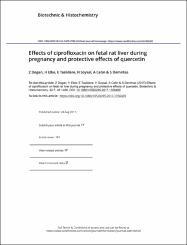| dc.contributor.author | Doğan, Z. | |
| dc.contributor.author | Elbe, Hülya | |
| dc.contributor.author | Taşlıdere, E. | |
| dc.contributor.author | Soysal, H. | |
| dc.contributor.author | Çetin, A. | |
| dc.contributor.author | Demirtaş, S. | |
| dc.date.accessioned | 2020-11-20T14:54:03Z | |
| dc.date.available | 2020-11-20T14:54:03Z | |
| dc.date.issued | 2017 | |
| dc.identifier.issn | 1052-0295 | |
| dc.identifier.issn | 1473-7760 | |
| dc.identifier.uri | https://doi.org/10.1080/10520295.2017.1356469 | |
| dc.identifier.uri | https://hdl.handle.net/20.500.12809/2096 | |
| dc.description | WOS: 000424145900003 | en_US |
| dc.description.abstract | Urinary tract infections are common in pregnant women and ciprofloxacin frequently is used as a broad spectrum antibiotic. It has been suggested that ciprofloxacin causes liver damage in fetuses. Quercetin is a flavonoid with antioxidant properties. We investigated the efficacy of quercetin treatment for preventing fetal liver damage caused by ciprofloxacin. Pregnant rats were divided into four groups: untreated control group (C), 20 mg/kg quercetin for 21 days group (Q), 20 mg/kg twice/day ciprofloxacin for 10 days group (CP), and 20 mg/kg, ciprofloxacin + quercetin for 21 days group (CP + Q). Fetal livers were removed on day 21 of gestation to measure antioxidants and for histological observation. Malondialdehyde (MDA) and glutathione (GSH) levels, and superoxide dismutase (SOD), catalase (CAT) and glutathione peroxidase (GSH-Px) activities were measured in tissue samples. GSH-Px, SOD and CAT activities were significantly lower in the CP group compared to group C. A significant increase in MDA was observed in the CP group compared to group C. There was no significant difference in GSH levels in any group. MDA levels were lower and CAT, SOD and GSH-Px enzyme activities were higher in the CP + Q group compared to group CP. Liver samples of the CP group exhibited central vein dilation, portal vein congestion, pyknotic nuclei and cytoplasmic vacuolization in some hepatocytes. Histological changes were less prominent in the rats treated with quercetin. Use of ciprofloxacin during pregnancy caused oxidative damage in fetal liver tissue. Oxidative stress was ameliorated by quercetin. Quercetin supports the antioxidant defense mechanism and it is beneficial for treating fetal liver damage caused by ciprofloxacin. | en_US |
| dc.item-language.iso | eng | en_US |
| dc.publisher | Taylor & Francis Inc | en_US |
| dc.item-rights | info:eu-repo/semantics/openAccess | en_US |
| dc.subject | Ciprofloxacin | en_US |
| dc.subject | Fetus | en_US |
| dc.subject | Liver | en_US |
| dc.subject | Pregnancy | en_US |
| dc.subject | Quercetin | en_US |
| dc.subject | Rat | en_US |
| dc.title | Effects of ciprofloxacin on fetal rat liver during pregnancy and protective effects of quercetin | en_US |
| dc.item-type | article | en_US |
| dc.contributor.department | MÜ, Tıp Fakültesi, Temel Tıp Bilimleri Bölümü | en_US |
| dc.contributor.institutionauthor | Elbe, Hülya | |
| dc.identifier.doi | 10.1080/10520295.2017.1356469 | |
| dc.identifier.volume | 92 | en_US |
| dc.identifier.issue | 7 | en_US |
| dc.identifier.startpage | 481 | en_US |
| dc.identifier.endpage | 486 | en_US |
| dc.relation.journal | Biotechnic & Histochemistry | en_US |
| dc.relation.publicationcategory | Makale - Uluslararası Hakemli Dergi - Kurum Öğretim Elemanı | en_US |


















